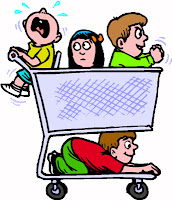Photo: Courtesy The Big Box of Art
This is Max Tell with my 6th instalment of writing exercises for professional and novice writers, those of you who are or would like to write poetry for kids.
Note: When referring to poems, I am also including songs. When referring to songs, I am usually focusing on the unique elements or qualities of songwriting.
In my last instalment, I talked about part one of Rhythm, and introduction.
RHYTHM: An Introduction - Part Two
Let's look at Jack and Jill Went Up the Hill again as I showed you last week.
JACK and JILL went UP the HILL
To FETCH a PAIL of WAter.
If you recall, the bold faced words or parts of words such as 'PAIL' and 'WA' emphasize stressed syllables, whereas unstressed syllables are not bold faced. This style of marking scansion is every good for beginners, but more advanced writers may wish to use the following method:
/ ^ / ^ / ^ /
Jack and Jill went up the hill
^ / ^ / ^ / ^
To fetch a pail of wa-ter.
There are numerous styles of marking scansion points. What I have done is made them as easy as possible to read and to type. In the example above, ( / ) marks stressed syllables and ( ^ ) marks unstressed syllables.
Let's look at a few more difficult rhythm patterns in the following stanza.
The old woman stands at the tub, tub, tub,
The dirty clothes to rub, rub, rub;
But when they are clean, and fit to be seen,
She'll dress like a lady and dance on the green.
Scan the above stanza yourself before reading on. Don't forget to clap your hands on the stressed syllables as you scan.
Comparing your results with my example below. How did you do?
^ / ^ ^ / ^ ^ / / /
The old woman stands at the tub, tub, tub,
^ / ^ / ^ / / /
The dir-ty clothes to rub, rub, rub;
^ / ^ ^ / ^ / ^ ^ /
But when they are clean, and fit to be seen,
^ / ^ ^ / ^ ^ / ^ ^ /
She'll dress like a la-dy and dance on the green.
Did you catch the three different patterns illustrated above, ( ^ / ), ( ^^/ ), and ( // ) ? You may think of them as ( da-DUM ), (da-da-DUM), and (DUM-DUM).
Try your hand at a few more stanzas or poems from a nursery rhyme book in the library or go to: www.mamalisa.
If you haven't done so already, scan a few of your own poems. If you haven't written any yet, now is a good time to start. If you're a beginner, keep your poems short and simple. Have fun.
www.maxtell.ca
Resources:
Scansion: For Advanced Poets
Rhythm & Meter: Advanced Study
Essential Children's Collection
Next topic: Although there is still lots more to be learned about Rhythm, for a change of pace next week, I'll talk about Spoonerisms and share one of my latest examples.
What would you like to know more about? Rhythm? Rhyme? Anything of your choice? Do you have a question about poetry? Your comments would be greatly appreciated.
www.maxtell.ca
Resources:
Scansion: For Advanced Poets
Rhythm & Meter: Advanced Study
Essential Children's Collection
Next topic: Although there is still lots more to be learned about Rhythm, for a change of pace next week, I'll talk about Spoonerisms and share one of my latest examples.
What would you like to know more about? Rhythm? Rhyme? Anything of your choice? Do you have a question about poetry? Your comments would be greatly appreciated.
Bye for now and see you soon.
Have a great writing day.
Max
Have a great writing day.
Max
PS: Like writing, but love editing.




No comments:
Post a Comment